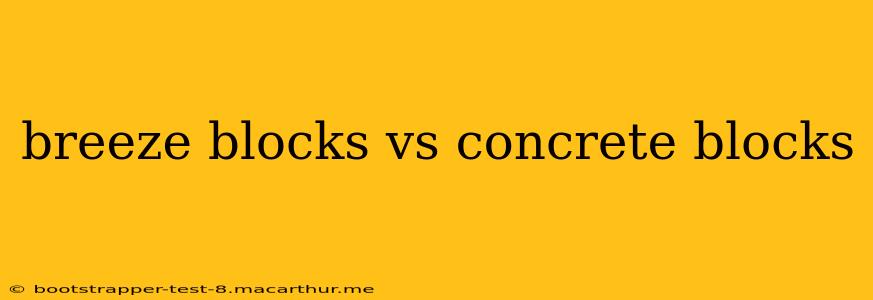Choosing the right building block can significantly impact the aesthetic appeal, structural integrity, and overall cost-effectiveness of your project. This comprehensive guide delves into the key differences between breeze blocks and concrete blocks, helping you make an informed decision. We'll explore their strengths, weaknesses, and ideal applications to ensure you select the best material for your needs.
What are Breeze Blocks?
Breeze blocks, also known as aircrete blocks or porous concrete blocks, are lightweight building blocks manufactured with a mixture of cement, sand, and aggregates, but with a significant proportion of voids. These voids create a distinctive pattern of holes, allowing for better ventilation and light penetration.
Advantages of Breeze Blocks:
- Improved Ventilation: The holes in breeze blocks allow for natural airflow, reducing the need for artificial ventilation and potentially lowering energy costs for cooling.
- Lightweight: Their porous nature makes them easier to handle and transport than solid concrete blocks. This translates to reduced labor costs during construction.
- Aesthetic Appeal: The unique patterns and textures of breeze blocks can add a decorative element to a building's exterior or interior walls.
- Cost-Effective (in certain situations): In some regions, breeze blocks can be a more affordable option than solid concrete blocks.
Disadvantages of Breeze Blocks:
- Lower Structural Strength: Compared to concrete blocks, breeze blocks have lower compressive strength, limiting their use in load-bearing applications.
- Less Insulation (against heat): While ventilation is good, breeze blocks offer less thermal insulation compared to solid blocks, potentially leading to higher energy bills in extreme climates.
- Susceptibility to Damage: Their porous nature makes them more vulnerable to damage from moisture and weathering. Proper sealing and maintenance are crucial.
- Limited Applications: Due to lower strength, they are unsuitable for foundation work or structures requiring high load-bearing capacity.
What are Concrete Blocks?
Concrete blocks, also known as cinder blocks or cement blocks, are solid or hollow masonry units made from a mixture of cement, aggregates, and water. They are significantly denser and stronger than breeze blocks.
Advantages of Concrete Blocks:
- High Compressive Strength: Concrete blocks offer superior structural strength, making them suitable for load-bearing walls and foundations.
- Excellent Insulation (against sound): Solid concrete blocks provide better sound insulation than breeze blocks.
- Durability: They are highly resistant to weathering and damage, ensuring longevity.
- Versatile Applications: Suitable for a wide range of construction projects, including foundations, load-bearing walls, and retaining walls.
Disadvantages of Concrete Blocks:
- Heavier: Their weight makes them more difficult to handle and transport, increasing labor costs.
- Less Ventilation: Solid concrete blocks offer minimal ventilation, potentially requiring more artificial ventilation.
- Can be more expensive: The cost of concrete blocks can sometimes be higher than breeze blocks, depending on location and availability.
- Less Aesthetically Pleasing (often): Their plain appearance might not suit all architectural styles.
Breeze Blocks vs. Concrete Blocks: Key Differences Summarized
| Feature | Breeze Blocks | Concrete Blocks |
|---|---|---|
| Strength | Lower | Higher |
| Weight | Lighter | Heavier |
| Ventilation | Excellent | Poor |
| Thermal Insulation | Moderate (can vary significantly) | Better (especially solid blocks) |
| Cost | Potentially Lower | Potentially Higher |
| Durability | Lower (requires more maintenance) | Higher |
| Applications | Non-load-bearing walls, partitions | Load-bearing walls, foundations |
What are the best uses for breeze blocks?
Breeze blocks are ideal for:
- Non-load-bearing internal walls: Where ventilation and light penetration are desired.
- External walls in mild climates: Where their aesthetic appeal is prioritized and structural requirements are less demanding.
- Decorative features: Creating unique patterns and textures in walls.
- Low-rise construction: In areas where their lighter weight is advantageous.
What are the best uses for concrete blocks?
Concrete blocks excel in:
- Foundations: Providing a strong and stable base for structures.
- Load-bearing walls: Supporting the weight of the building.
- Retaining walls: Holding back earth or other materials.
- High-rise construction: Where their structural strength is crucial.
Which is better for insulation?
Solid concrete blocks generally offer better thermal insulation than breeze blocks. However, the type of concrete block, its density, and the presence of insulation within the wall cavity are significant factors affecting the overall thermal performance. Breeze blocks offer superior ventilation, but this doesn't equate directly to better thermal insulation.
Which block is cheaper?
The relative cost of breeze blocks and concrete blocks can vary depending on location, availability, and market conditions. In some regions, breeze blocks are cheaper, while in others, concrete blocks might be more affordable. Always obtain quotes from local suppliers to determine the actual costs.
By carefully considering the advantages and disadvantages of each type of block and their suitability for your specific project, you can make an informed decision that ensures both structural integrity and aesthetic satisfaction. Remember to consult with a qualified builder or architect to determine the best choice for your particular needs.
